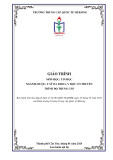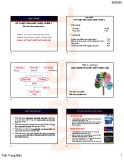
128 Hoa Binh University Journal of Science and Technology - No 14 - 12.2024
PHARMACEUTICALS
NANOPARTICLE FORMULATION OF ROSUVASTATIN:
ENHANCING SOLUBILITY AND CLINICAL POTENTIAL
Assoc. Prof., Dr. Le Quang Huan1, Dr. Ha Thi Thanh Huong1,
Doctor. Dao Huu Hoang2, Specialist level 2 Doctor. Van Tat Chien2,
Nguyen Minh Hien3, Ngo Phuong Thuy3
1Hoa Binh University
2SPM Joint Stock Company
3VNU University of Medicine and Pharmacy
Corresponding Author: huanlequang@gmail.com
Received: 09/12/2024
Accepted: 20/12/2024
Published: 24/12/2024
Abstract
Rosuvastatin is a potent statin used in the management of dyslipidemia and the prevention of
cardiovascular diseases. However, its low water solubility limits bioavailability and therapeutic
outcomes. This study outlines a nanotechnology-based method to enhance its solubility and
absorption of rosuvastatin. The process entails the formulation of rosuvastatin nanoparticles
through a combination of precipitation and ultrasonic techniques. Rosuvastatin is initially dissolved
in an organic solvent, such as acetone, and subsequently mixed with an aqueous phase containing
stabilizers like Poloxamer 407 or PVP to induce precipitation. Ultrasound reduces particle size
to 50-200 nm. Key parameters, including drug-to-stabilizer ratio, stirring speed, ultrasound
duration, and temperature, were systematically optimized to archive uniform, nanoscale particles.
The resulting nanoparticles exhibit improved stability and solubility, achieving a 6.8-fold increase
compared to unmodified Rosuvastatin. Additionally, the application of nanotechnology safeguards
the drug against gastric degradation, reduces the required dosage, and minimizes potential side
effects. This approach offers promising applications for poorly soluble drugs and significantly
improves therapeutic efficiency, marking a step forward in pharmaceutical development for better
patient outcomes.
Keywords: Rosuvastatin, cardiovascular, solubility, cancer, nanoparticle.
Công thức hạt nano Rosuvastatin: Tăng cường độ hòa tan và tiềm năng lâm sàng
PGS.TS. Lê Quang Huấn1, TS. Hà Thị Thanh Hương1, BS. Đào Hữu Hoàng2, BSCKII. Văn Tất
Chiến2, Nguyễn Minh Hiển3, Ngô Phương Thủy3
1Trường Đại học Hòa Bình
2Công ty Cổ phần SPM
3Trường Đại học Y dược, Đại học Quốc gia Hà Nội
Tác giả liên hệ: huanlequang@gmail.com
Tóm tắt
Rosuvastatin là một statin mạnh để quản lý rối loạn lipid máu và phòng ngừa các bệnh tim
mạch, nhưng độ hòa tan trong nước thấp của nó hạn chế sinh khả dụng và hiệu quả điều trị. Nghiên
cứu này trình bày một phương pháp dựa trên công nghệ nano nhằm cải thiện độ hòa tan và hấp thu
của thuốc.
Quy trình bao gồm việc tạo ra các hạt nano Rosuvastatin bằng cách kết hợp phương pháp kết

No 14 - 12.2024 - Hoa Binh University Journal of Science and Technology 129
PHARMACEUTICALS
tủa và siêu âm. Rosuvastatin được hòa tan trong dung môi hữu cơ (ví dụ: acetone) và trộn với pha
nước chứa các chất ổn định như Poloxamer 407 hoặc PVP để tạo kết tủa. Siêu âm được sử dụng để
giảm kích thước hạt xuống còn 50-200 nm. Các thông số quan trọng, bao gồm tỷ lệ thuốc với chất
ổn định, tốc độ khuấy, thời gian siêu âm và nhiệt độ, đã được tối ưu hóa để tạo ra các hạt đồng đều
ở kích thước nano.
Các hạt nano thu được cho thấy tính ổn định và độ hòa tan được cải thiện, tăng 6,8 lần so với
Rosuvastatin dạng thô. Công nghệ nano cũng bảo vệ thuốc khỏi sự phân hủy trong dạ dày, giảm liều
lượng cần thiết và hạn chế tác dụng phụ.
Phương pháp này mang lại ứng dụng tiềm năng cho các loại thuốc có độ hòa tan kém, đồng thời
cải thiện đáng kể hiệu quả điều trị, đánh dấu một bước tiến trong phát triển dược phẩm nhằm mang
lại kết quả tốt hơn cho bệnh nhân.
Từ khóa: Rosuvastatin, cardiovascular, solubility, cancer, nanoparticle.
Introduction
Rosuvastatin, a member of the statin class
of drugs, is widely used in conjunction with a
suitable diet to lower low-density lipoprotein
cholesterol (LDL-C) and triglycerides while
increasing high-density lipoprotein cholesterol
(HDL-C) in the blood. By inhibiting hepatic
cholesterol synthesis, Rosuvastatin reduces the
risk of cardiovascular diseases, including heart
attacks and strokes. Among statins, Rosuvastatin
calcium (ROSC) is particularly effective,
earning its designation as a "superstatin" due to
its ability to reduce LDL-C levels by up to 63%
at a 40 mg dose.
Despite its efficacy, ROSC has poor water
solubility, with oral bioavailability limited
to approximately 20%, classifying it as a
Biopharmaceutics Classification System (BCS)
Class II drug. This low solubility constrains its
dissolution rate and, consequently, its systemic
absorption. Following oral administration, ROSC
is rapidly absorbed, achieving peak plasma
concentrations within 5 hours. It has a half-
life of approximately 19 hours and is primarily
eliminated via feces (~90%).
Rosuvastatin is indicated for the treatment
of various lipid disorders, including primary
hypercholesterolemia, hypertriglyceridemia,
mixed dyslipidemia, and familial
hypercholesterolemia. ROSCa has also
demonstrated potential therapeutic effects in
the management of osteoporosis, Alzheimer's
disease, and benign prostatic hyperplasia. More
recently, ROSCa has been investigated for its
anti-cancer properties, with studies revealing
its ability to inhibit the growth of Caco-2
cells, a human colorectal cancer cell line.
Mechanistically, ROSCa acts as a selective and
competitive inhibitor of HMG-CoA reductase,
the rate-limiting enzyme in the biosynthesis
of cholesterol. Specifically, ROSCa blocks
the conversion of 3-hydroxy-3-methylglutaryl
coenzyme A (HMG-CoA) to mevalonate, a
crucial precursor for cholesterol production
(Bansal et al., 2024). This inhibition leads to: (i)
an upregulation of low-density lipoprotein (LDL)
receptors on hepatocytes, thereby enhancing the
hepatic uptake and catabolism of LDL particles,
and (ii) a reduction in the synthesis of very low-
density lipoprotein (VLDL) in the liver, which
subsequently lowers the overall circulating levels
of both VLDL and LDL particles.
To address the challenge of poor solubility,
various strategies have been investigated to
enhance the dissolution and bioavailability
of ROSC. These include techniques such
as ß-cyclodextrin complexation, solid
dispersion, hydrotropy, micellar solubilization,
and nanoemulsion systems (Akbari et al.,
2011; Nainwal et al., 2011). Among these,

130 Hoa Binh University Journal of Science and Technology - No 14 - 12.2024
PHARMACEUTICALS
nanotechnology-based approaches have
gained particular attention, demonstrating
significant potential to improve the solubility
and oral bioavailability of ROSC (Alshora et
al., 2018; Palani et al., 2015; Gabr etal, 2018;
Krishnamoorthy et al., 2013).
In summary, while rosuvastatin calcium is
highly effective for managing dyslipidemia and
preventing cardiovascular events, enhancing
its solubility remains critical for optimizing its
therapeutic efficacy. The application of advanced
formulation strategies continues to demonstrate
p otential in overcoming this limitation.
This study introduces a method for the
fabricating nanosized rosuvastatin calcium
particles aimed at improving the drug's solubility
and bioavailability through a ball milling
technique, utilizing excipients and stabilizers
such as Pluronic-F127 and Polyvinylpyrrolidone
K-30 (PVP-K30).
The resulting nanorosuvastatin product
was evaluated using the MTS assay, a widely
used method for assessing metabolic activity
and cell viability in biological research. The
MTS (3-(4,5-Dimethylthiazol-2-yl)-5-(3-
carboxymethoxyphenyl)-2-(4-sulfophenyl)-
2H-tetrazolium) assay involves the conversion
of a tetrazolium salt into a measurable colored
product through the action of reducing enzymes
in living cells. During the assay, MTS is added
to the cell culture medium, where it reacts with
NADPH-dependent dehydrogenase enzymes
present in metabolically active cells. When the
cells are metabolically active, MTS is reduced
to a colored compound, and the intensity of this
color can be measured using a spectrophotometer.
The color intensity is proportional to the level of
metabolic activity of the cells, thereby allowing
the growth rate or survival of the cells in the test
medium to be determined (Wang et al., 2020).
2. Materials and Methods
2.1. Materials
Rosuvastatin calcium (GR) supplied by
SPM, excipients PVP (Sigma), Tween-80
(Sigma), Pluronic F-127 (Sigma) and other
excipients. Equipment: Rotary evaporator,
freeze dryer, ball mill, magnetic stirrer, and
other equipment. Cell line human gastric cancer
cells (AGS), liver cancer cells HepG2, leukemia
cells HL-60; RPMI medium, DMEM medium.
2.2. Methods
- Development of the Rosuvastatin
Calcium Standard Curve
The standard curve for rosuvastatin calcium
concentration is constructed by dissolving
rosuvastatin calcium (GR) in methanol at
concentrations of 20, 30, 40, 50, and 100 µg/
mL. The The optical density OD is measured
at a wavelength of 244 nm. A linear equation
is then derived to represent the correlation
between concentration and OD244.
- Determination of the Product Solubility
Dissolve 50 mg of the lyophilized product
(NR3) and 50 mg of Rosuvastatin calcium
(GR) in 1 mL of H2O to saturation. Centrifuge
at 3000 rpm for 5 minutes and collect the
supernatant from the samples. Repeat the
centrifugation step 3 times.
Lyophilize the centrifuged supernatant, then
dissolve in Methanol and determine the OD at 244
nm. Develop a standard equation to determine the
solubility of nanoRosuvastatin calcium.
- Preparation of Rosuvastatin Calcium
Nanoparticles (NR)
The ball milling technique was used to
produce nanorosuvastatin to enhance the
solubility and bioavailability of rosuvastatin
calcium using Rosuvastatin calcium, Pluronic
F127, polyvinylpyrrolidone (PVP), Tween 80,
and water at a weight ratio of 1:1.5:0.5:0.3.
The mixture of components was milled for 90
minutes, with a cycle of 15 minutes of operation
and 5 minutes of rest, at a speed of 250 rpm.
After milling, the sample was freeze-dried at
-50°C to obtain the final product. The product
was stored at 4oC and store at 4°C until use.
- Determination of Product Size
The particle size and zeta potential of the

No 14 - 12.2024 - Hoa Binh University Journal of Science and Technology 131
PHARMACEUTICALS
Fig1. The Standard Curve of Rosuvastatin calcium Concentration
with R2 value of 0.9992
obtained product are determined using dynamic
light scattering (DLS) and laser Doppler
anemometry (LDA), respectively, with a
Zetasizer 3000 (Malvern Instruments, UK). The
nanoparticle suspension was filtered through a
0.45 µm filter, and each sample was analyzed
three times.
- Cultivation of Cancerous and Non-
Cancerous Cell Lines
The human gastric cancer cell line (AGS)
is cultured in RPMI medium, while the HepG2
liver cancer cell line and leukemia cell lines
HL-60 (acute promyelocytic leukemia) are
cultured in DMEM medium at 37°C with 5%
CO2. Both culture media contain 10% FBS and
1% penicillin-streptomycin. To maintain the
cells in their exponential growth phase, they are
passaged twice a week.
- Drug Testing on Cell Lines
MTT and MTS assays exhibit several
similarities, primarily in their application for
measuring cell viability in vitro. Both assays
evaluate the impact of various compounds
on cell proliferation and cytotoxicity and are
classified as colorimetric assays. Another
similarity is both assays measure the metabolic
activity of cells based on their ability to create
formazan crystals, utilizing NADPH as the
reduction agent. Additionally, both assays
must be conducted in the dark due to the
light sensitivity of the MTT reagent. Finally,
the incubation periods for both assays are
consistent, lasting between 1 to 4 hours at
37 degrees Celsius. The IC50 values were
determined based on the percentage of cell
growth inhibition:
In which: HighConc/LowConc: Test
substance at high concentration/Test substance
at low concentration; High
Inh%/Low
Inh%: %
inhibitory at high concentrations / % inhibitory
at low concentrations.
3. Results and Discussion
Solubility of Nanorosuvastatin
The results of constructing the standard
curve of rosuvastatin calcium concentration
(GR) are presented in Figure 1 and the linear
equation between the optical density (OD244)
and rosuvastain calcium concentration is
expressed by the equation: Y= 0.0056X +
0.0415, with an R2 value of 0.9992. The
concentration of Rosuvastatin calcium in the
sample was determined using the titration
equation, which subsequently allowed for the
determination of the solubility of the resulting
product compared to the original sample as
detailed above (Table 1).

132 Hoa Binh University Journal of Science and Technology - No 14 - 12.2024
PHARMACEUTICALS
Table 1. Solubility of Rosuvastatin calcium (GR) and Nanorosuvastatin (NR3)
The solubility of Nanorosuvastatin calcium (NR3) is 6.89 times higher than that of crude
Rosuvastatin calcium (GR).
Product Size
The particle size and zeta potential of the nano rosuvastatin (NR3) were determined using a
Zetasizer 3000 (Malvern Instruments, UK) as shown in figures 1.
Figure 1. The particle size and zeta potential of the nano rosuvastatin (NR3).
The obtained product has a Rosuvastain calcium content of 68.02%.
The average particle size is 144 nm. Zeta potential: -5.49 mV
The Toxicity of Nano rosuvastatin (NR3)
The toxicity of nano rosuvastatin (NR3)
was determined on the gastric carcinoma cell
line AGS, hepatocellular carcinoma HepG-
2 and leukemia cell lines HL-60 (acute
promyelocytic leukemia). Cells were seeded at
a density of 5,000 cells/well in a 96-well plate
and maintained in 5% CO₂ at 37°C. After 24
hours, NR3 and GR were treated with a range
of rosuvastatin concentrations (0–100 μM).
Control cells were not supplemented with the
test substance. Evaluation of the inhibition and
cell death levels by MTT method of NR3, GR
and the excipients used to create NR3 on tested
cell lines is shown in Figure 2, 3 ,4, 5.
After 72 hours of treatment, cell viability
was assessed using the MTT assay. The
differences in survival and inhibition rates
between control and excipient-supplemented
samples at different concentrations were
not statistically significant each sample was
conducted in triplicate.












![Bài giảng Vi sinh vật: Đại cương về miễn dịch và ứng dụng [chuẩn nhất]](https://cdn.tailieu.vn/images/document/thumbnail/2025/20251124/royalnguyen223@gmail.com/135x160/49791764038504.jpg)













